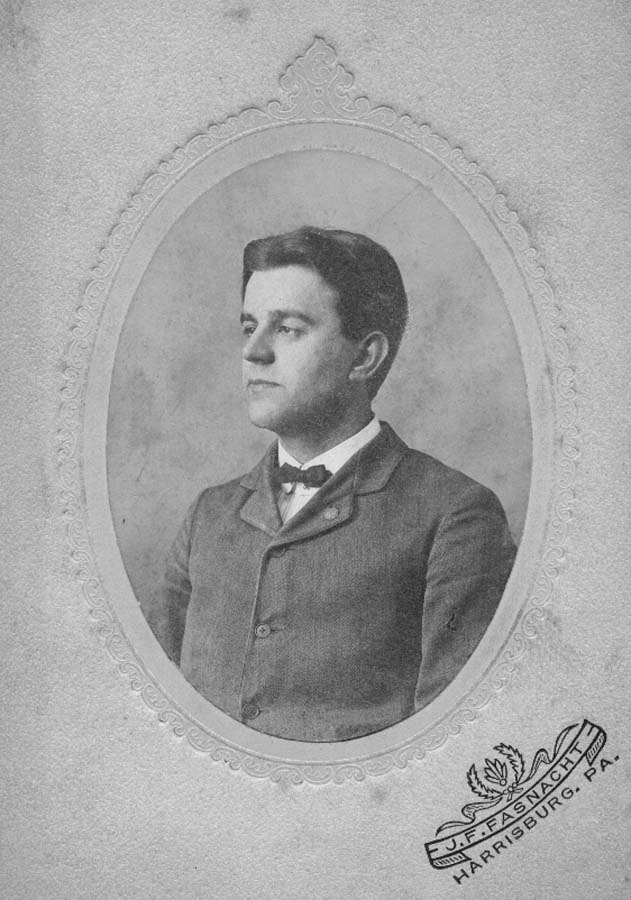
Nevin W. Moyer
teacher, historian, patriot

Nevin W. Moyer
LAFAYETTE’S VISIT TO HARRISBURG IN 1825
An Interview with Nevin W. Moyer by Galen Frysinger
Paxton Rangers Historic Association, Lower Paxton High School
(Published in "The Junior Historian" Vol. III, Number 2, Harrisburg, October 1945)
To simply tell you the story of this great man’s visit to Harrisburg without telling you, first, why this man was invited to
come to America and without telling you of his life before the visit, this visit would not be understood and would not be
appreciated today, as it was with our forefathers, 120 years ago.
Lafayette was born in Auvergne, France, September 6, 1757, the son of a noble family distinguished in the service of the
State of France. He was named Marie Joseph Paul Roch Yves Gilbert du Motier, Marquis de Lafayette. He was handsome,
polite, courteous, brilliant and wealthy. When a boy, he became a page to the queen of Louis XV.
The young Lafayette fell in love with a beautiful French girl and married her, when he was only sixteen years old. At a
banquet in 1775, in honor of the brother (The Duke of Gloucester) of King George III, he heard of the uprising in he
American Colonies. He was won by its arguments, and from that time, joined his hopes and sympathies to the American cause
for liberty. yet, how was he to aid it? The French nobility, though disliking England, did not endorse the actions of her
colonies. He was not yet twenty Tears of age. He had married a woman, whom he tenderly loved, his prospects at home for
honor and happiness were bright; to join the patriot army would take him from his native land, his wife, and all his coveted
ambitions, and lead him into a struggle that seemed as hopeless as its cause was just. Yet his zeal for American Liberty
overcame all these obstacles. Other difficulties now arose: his family objected, the British Minister protested and the
French King withheld his permissions. Still undaunted, he purchased a vessel, fitted it out at his own expense, and escaped
the officers who were sent to detain him at Bordeaux, France. Now he knew that his family, the State of France and even
England were trying to halt his ideas, and that spies were on his heels for his arrest. He felt it was not safe for him to stay
at Bordeaux, therefore, he changed his dress to that of a courier and traveled by coach to Bayonne and from thence to St.
Jean de Luz; he was recognized, by a former friend, but he warned this friend not to say a word. By various means he
finally reached Passage, a Spanish port, in safety, and on March 26, 1777, the prow of his gallant vessel, “The Victory,” was
turned toward America.
As soon as the King of France received news of his departure, dispatches were instantly sent to the West Indies, to arrest
Lafayette, should his vessel, as was expected, stop there on its way. The. sagacity of the Marquis was, however, equal to
the emergency. Suspecting that he might be detained should he touch at the Islands, as soon as he got fairly to sea he
ordered the captain to steer directly for the American coast. This officer at first refused, but the Marquis was unyielding,
and the course of the vessel was accordingly changed. The ship was heavy, and its slow sailing and rolling motion soon added
seasickness to the trials of this young soldier. He finally landed at Winyan Bay about sixty miles northeast of Charleston,
South Carolina, on June 13, 1777, thus taking ninety days to make this trip.
Lafayette at once started north, met Continental Congress at York and received an appointment from the Congress as a
Major General. He became an intimate friend of General Washington and such he remained. He was wounded at the Battle
of Brandywine, but served at Monmouth as well as in the Rhode Island Campaign. He returned to France in 1779. However,
on April 28, 1780, he returned to America, and was a member of the board of judges in trial of Major Andre. In 1781, he
commanded in Virginia against Arnold and Cornwallis, was present at the surrender of Cornwallis and returned to France
after the close of the war. He made a brief visit to America in 1784, when he was joyfully received by the American
people.
In 1824, our Revolutionary hero was sixty-seven years old. Both President Monroe and Governor Schulze (Governor of
Pennsylvania 1823-1829) were eager to receive this Revolutionary hero in America when they heard that he was having
difficulty in France. The Congress of the United States sent him an invitation to visit America at this time. This he
accepted. When it was known that he was going to visit, the whole country was eager to receive him. Even the smallest
hamlet was anxious to give him a triumphant reception. He sailed on the “Cadmus” from Le Havre, France, on July 12, 1824,
accompanied by his son, George Washington Lafayette, and a Mr. Levisseur. Arriving in New York on August 15, 1824, he
was given the National salute of artillery, and the whole town was enthusiastic when it heard of his arrival. Since it was
Sunday, Vice President Tompkins took him to his home on Staten Island, to stay until the National program would begin on
Monday.
On Sunday, January 30, 1825, Harrisburg was notified that the General and his party had left York and were on their way
to the city. This was a bitterly cold day. Whereupon Messrs. Hawkins and Baker of the joint committee of the Legislature
and M. C. Rogers, Esquire, Secretary of the Commonwealth, proceeded from Harrisburg, in carriages, toward York. They
were escorted by the Dauphin Cavalry by way of Middletown, for the purpose of meeting the General’s party. Dinner was
prepared for them at Middletown, and there the chief bugler, Daniel Moyer, (grandson of Nevin W. Moyer) was sent
forward to ascertain if the General was upon that road.
At about 10:30 A.M. the General, his son, secretary, and General Spangler, and Dr. King—a committee escorting him from
York—were received at Middletown and took dinner.
They arrived about 5:00 P.M. in Harrisburg and were hailed with great enthusiasm by the expectant crowd. The General and
his party were then escorted to the Governor’s residence. Here, while the Dauphin Cavalry were waiting on General
Lafayette at the Governor’s residence—where they nearly froze their legs—the General recognized them and said that it
would give him great pleasure to see them all at his lodgings that evening. The troop was then dismissed. That evening,
members of the Troop, with many other citizens, paid their respect to Lafayette and were highly delighted.
Because we have been at war, and we have seen soldiers of all branches of the service every day, I think it would be very
interesting to know how the Dauphin Cavalry was dressed:
Each member shall wear on day of parade a black leather helmet cap, surmounted with a white ostrich plume, and band of
silver lace around the rower part, one-half inch wide; a black cravat or stock; a blue cloth roundabout, with four and a half
dozen white bullet buttons, of which there shall be three rows in front and six on each sleeve; standing collar, lined with
red, a small silver star on each side, encircled with black cord; the coat to come to a peak in front; blue pantaloons with six
bullet buttons at the extremity of each leg in winter, and plain white pantaloons in summer, short boots and spurs.
Each member also to provide himself with a steel scabbard sword, and black leather belt; a pair of pistols; and holsters
with bear skin top; saddle’ with bear skin housings, leather halter, martingale, and bridle. The non-commissioned officers,
to wear satin or silver lace on their coat sleeve, in quantity, proportioned to their grade.
During the three days that General Lafayette spent in Harrisburg, he was continually busy. He visited the Capitol, the
House of Representatives, the Senate, the Harrisburg Bar, Perseverance Lodge of Masons, and also attended many
banquets. But he always retired early, as was the custom at that time.
When he went from one place to the other—the Governor’s residence to the Capitol—he was escorted by a corps of
dragoons, under Major Forster. This organization was also known as the Dauphin Cavalry.
Lower Paxton and Linglestown always stood high in matters pertaining to education. The Shoops School at Shoops Church,
later Crums, and now a part of the Lower Paxton Consolidated School, sent a written patriotic address to the General
signed by the pupils which was handed to him at his lodgings. The General replied to this, a few days after, by letter from
Washington. I wonder where this letter might be?
In the Battle of Monmouth, the sword and regimental flag of Colonel Monckton was captured by captain William Wilson of
Northumberland. Captain Wilson gave the sword to General Anthony Wayne, who presented it to General Lafayette, who
in turn took it to France. When he returned to America 1824-25, he brought the sword with him to restore it to Captain
Wilson in person. The Captain having died in 1813, General Lafayette handed it instead to Colonel Samuel Hunter, who
presented. it to Judge A. S. Wilson, the son of Captain William Wilson.
On Wednesday morning, the Volunteers were paraded in Market Square and reviewed by General Lafayette, who was
accompanied by the Governor. After this they saluted him at his quarters. At eleven o’clock, be took his departure for
York, accompanied by his suite, two of the committee of arrangements of the Legislature, the Secretary of the
Commonwealth and the Dauphin Cavalry, headed by a pair of buglers playing in harmony.
On September 6, 1825, the anniversary of his birthday, Lafayette enjoyed his last fete in America at Washington. On the
same day he embarked, at the head of the Potomac, on the frigate “Brandywine,” which had been set apart to convey him to
France, and the following morning his ship weighed anchor and spread her sails to the breeze. Perhaps sadness fell upon
the heart of Lafayette, as his eyes caught the last glimpse of the receding shore, for he may have known that he would
never see it again.
Next to our beloved Washington, he was hailed as the deliverer of this country and nowhere was he made more welcome
than in Philadelphia, Lancaster, York, Harrisburg, Uniontown, Pittsburgh and other Pennsylvania communities.
Lafayette’s family met him at Le Havre, France, and his tenants flocked around him as be drew near to “La Grange,” his
home. There he died on May 20, 1834, at the age of seventy-six. His body rests in a tomb in Paris and nearly every
American who visits Paris pauses at the tomb of the hero.
The news of the death of General Lafayette reached America, on the arrival of the packet ship “Silas Richard,” at New
York from Liverpool, England, on June 19, 1834.
Reversed rules, in deepest black, lined the editorial column of the Harrisburg Chronicle on June 23, 1834, in announcing
the death of the immortal Lafayette. The story was headed “Lafayette is No More !!” Two columns giving his life history
appeared in the Harrisburg Reporter of June 26, 1834.
On Monday, July 21, 1834, the citizens of Harrisburg united in paying honor to the memory of Lafayette. Stores and
offices were closed and large crowds of strangers came from out of town. The discharge of minute guns, fired from
Capitol Hill, and the mournful tolling of bells, announced that the hour for the ceremonies had arrived. The procession
formed in Front Street, moved ‘through the town and ended at the Salem Reformed Church, where a programme was
rendered. Major John. M. Forster, a former member of the Dauphin Cavalry, was the Chief Marshal. Many organizations
were represented in the procession. The Harrisburg fire company had eight men bearing banners and a coffin. The last
fire outfit was that of “Hope Company” carrying a large portrait of the General and a banner which read, “The Nation
Mourns the Death of Lafayette.” Might some of these parade trophies still exist?
Objects Mr. Moyer Has of General Lafayette’s Day
A Clews platter, 7x10 inches, “The Landing of Gen. -Lafayette, 16 August, 1824.”
A silver plated stirrup, saber and saddle belonging to Daniel Moyer, the chief bugler of the Dauphin Cavalry.
Pistols and holsters.
A sword that may have been Lafayette’s (Lafayette came to York to receive his higher command from the Continental
Congress and if he received a higher commissioned sword at that time, he may have left his own in York).
Constitution, By-Laws and Roster of the Dauphin Cavalry, printed 1822.
![]()
MEMORIES OF CHRISTMAS
An Interview With Nevin B. Moyer by Galen Frysinger
Paxton Rangers Historic Association, Lower Paxton High School
(Published in "The Junior Historian" Vol. III, Number 3, Harrisburg, February 1946)
I want you to get a real picture of my three part story; the home, the church and the school. In order for you to get
that picture, I will have to take you to the large 140—acre farm, the first farm east of Ling1estown where I was born.
There my parents, the B.F. Moyer’s, as well as my grandparents and great grandparents, Joseph and Henry Meese
(Mease, Miese) lived. It was on this farm that Andrew Berryhill lived when he was killed by the Indians, and the rest of
the family escaped. through the wilderness to Fort Hunter. (Six miles north of Harrisburg at the junction of Fishing
Creek and the Susquehanna River. See Frontier Forts of Pennsylvania, I. 9.) Andrew Berryhill is buried behind his old
house, with others of the family and the graves are not marked. His son, Alexander, became one of the early burgess’
of Harrisburg in which city there are a hill and a street named for this family. We read, in our early history of Dauphin
County, of the famous Battalion Drill ground, at Linglestown. The noted drill ground is on this farm. Here, too, was an
underground railroad depot, the home of Frances Wenrich and Colonel John Umberger. About 1725, the
Presbyterians established a school and mission and in 1791, the Lutheran and Reformed congregations were organized in
this building on this farm.
I feel that you have a picture of the community that I am going to talk about. When I was a lad, I spent my spare
moments with old people and listened to them telling stories of the past, These valuable stories I have preserved in
ledgers. Now the story is quite different. I am to take the place of the old persons and tell you young folks stories
about Christmas when I was a boy; and that would be sixty and more years ago.
Christmas at Home
When I was a lad we had welcome visitors. One came on Christmas Eve, with candy, nuts and a switch, with hat and coat
turned inside out. This was Mr. Belsnickle.
Woe to any person who would try to pick up any of the presents, which he threw on the floor, for they were apt to be
hit with his switch. This caused a great deal of fun if you got hit or missed and got the candy.
When I became older, we Belsnickles would drive through the country, visiting homes where there were children — in
particular girls of our age. At these homes we would be treated to fruit and cake. In Linglestown there were many
Belsnickles going from house to house on that Christmas eve; both home-people and Belsnickles having a good time.
The home Christmas tree was decorated with home made objects which were cut-out cakes, objects cut from paper, pop
corn strung on a string, pop corn balls, and a few clear toys, bought from Mr. Felix on Market Square in Harrisburg
where I ate many plates of good home—made ice cream. After returning from a teaming trip across the river, by way
of the old Camel Back Bridge (The Camel Back bridge crossed the Susquehanna at Front and Market Streets) or from
hauling hay to Harrisburg, we would tie our six horses to the northwest corner of the market house in the Square, a few
feet above the city scales. Mr. Felix was the way master. I have two pieces of the famous candy made by the Felix
moulds. (Henry Felix, 10 Market Square, See Then and Now In Harrisburg by Marian Inglewood, 63.)
Before going to bed, our stockings were hung up at the chimney corner, and our high leather boots were placed at the
side, for Santa to fill — we were sure of them being filled by him. The doors were locked and the only way for him to
get in, was down the chimney. We felt this was an easy passage way for him, for we very often saw Mr. Peters and Mr.
Adley, the old chimney sweeps, crawl up the chimney - scraping all the soot out as they crawled upward — and, finally, we
saw them sitting on the top of the chimney, singing their “Chimney Sweep Song.” Then they disappeared down the
chimney, washed themselves, got their twenty—five cents, and went off to the next neighbor to clean his chimney and
earn another twenty-five cents.
Next morning, when we arose early to see what Santa had brought us, there was much joy and laughter. We prepared to
eat our turkey at home, or go to the home of some uncle or aunt. In those days we had many uncles and aunts
Christmas in Our Church
For weeks, we practiced, at least three times a week to prepare a program for the Christmas celebration. When this time arrived people came from far and near. The church was filled, even in the aisles.
We had a Christmas tree in the church and that, too, was decorated very much like the home tree. However, this one
often had lighted tallow candles hidden in it here and there. This looked very beautiful although sometimes the candles set
the tree on fire. Candy and oranges were given to the children.
Christmas in the Schoolroom
A book could be written on the penning out of the teachers. The pupils came to school before daylight to pen the teacher out until he would promise to give them a treat. I know of some instances when the pupils were victorious and some when the teacher won out. It was the custom of that day and was fun for the pupils. My father - a teacher — had interesting stories to tell of how he went to school, with a wash basket full of baked Christmas cakes in the shapes of birds, roosters, horses, rabbits, men and women, etc. By giving this treat, he won the respect of both pupils and parents.
We had teachers who would visit the school house in the morning, find it barred and asked to be let in and when
they were refused went home. Finally, after the teachers were penned out for two weeks, the directors had to
open the school. At another time, a teacher promised a treat. The next day he came to school with two large
baskets filled with paper covered parcels. Pupils were good and things went fine that day. In the evening when
each pupil went out the door he was handed one of these packages, which when opened, disclosed a nice, red
corncob. I need not tell you that thereafter this teacher did not have the respect of either pupils or parents.
I am happy to say, I am teaching my forty-eighth year and I was never penned out. I always gave the pupils a respectable
treat and I have the respect of then and their parents.
Christmas Abroad
The Christmas of 1916, I was in the cavalry service during the Mexican trouble. That day we had our worst sand storm; our turkey was covered with sand and our eyes were blinded with dust: the Christmas of 1917 I was with the Twenty eighth Division, we had a bad snowstorm: the Christmas of 1918, found us in Belgium, where my organization, the Twenty-eighth Division, halted along the side of one of the Belgian highways and where, amid piercing cold winds and snow squalls, I ate my Christmas dinner, with my mess pan on the top of the broad wheel of one of our heavy Howitzers.
![]()
Nevin Moyer, my Mentor, wrote these articles for me to present
before an audience.
It was a learning
experience for me which I greatly appreciated.
It also gave me an opportunity to view many of the items in Mr. Moyer's house
museum.
Many Thanks
![]()
Nevin W. Moyer
as a teacher at Oakdale School
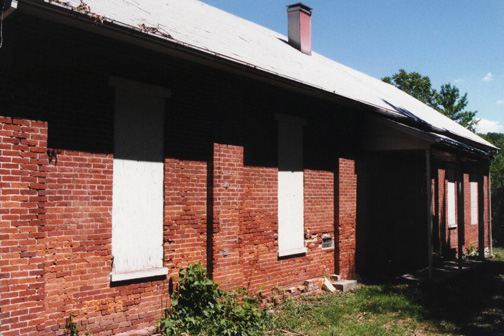
As it appears in 1999
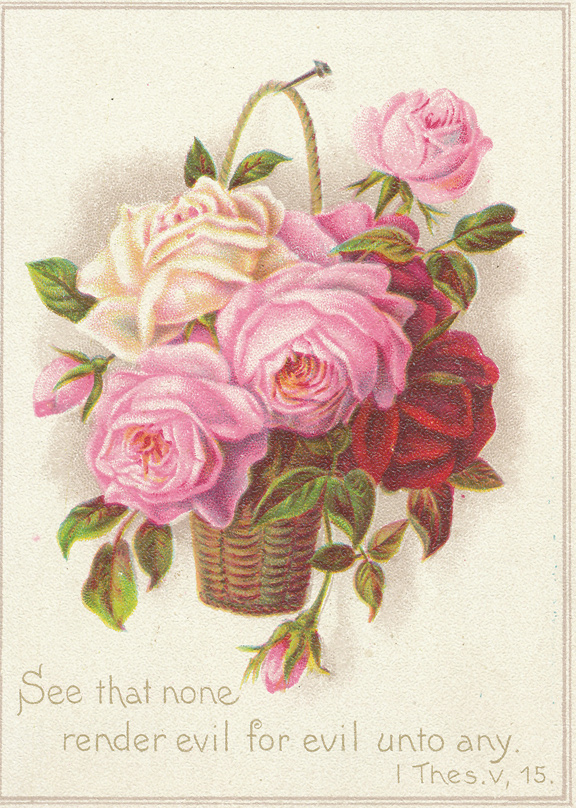
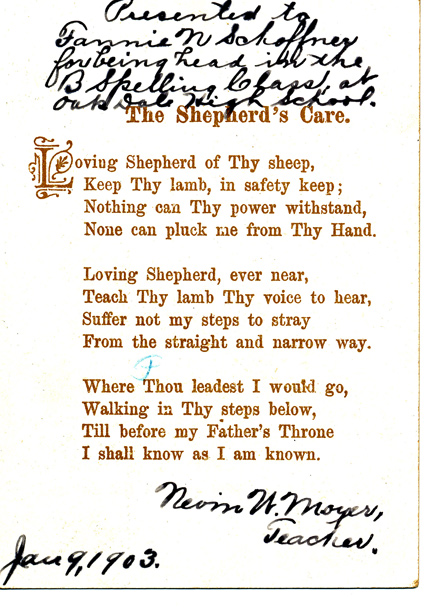
notes to my grandmother's sister Fannie Schaffner
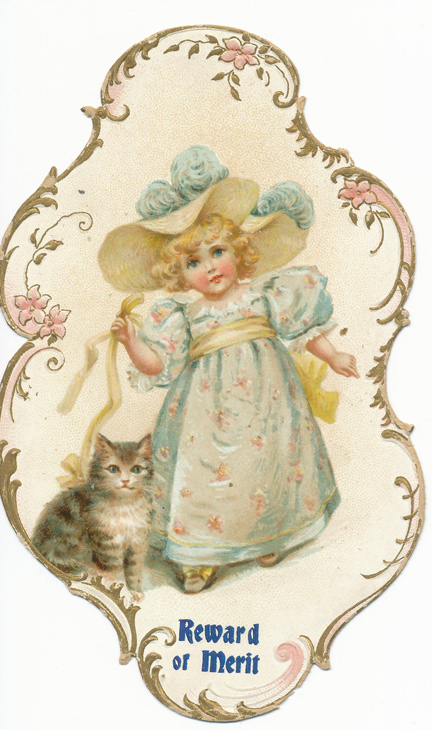
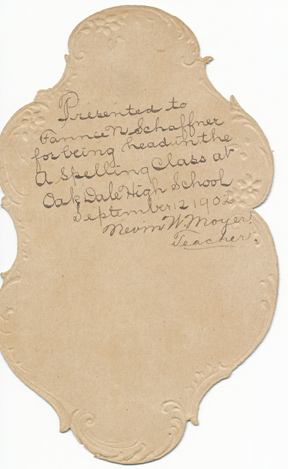
![]()